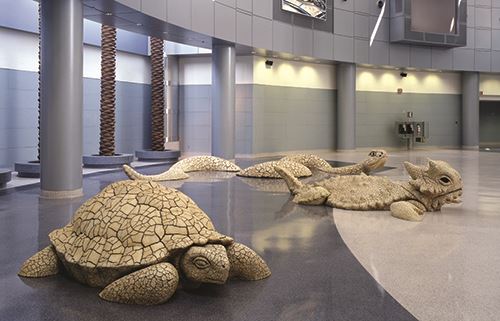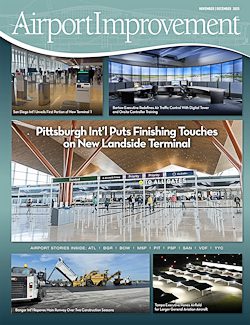There’s much more to Las Vegas than bustling casinos and glitzy stage shows.
There’s much more to Las Vegas than bustling casinos and glitzy stage shows. Harry Reid International Airport (LAS) uses artwork to remind visitors about the area’s red rock canyons, Aztec sandstone and ancient petroglyphs. One of the airport’s most enduring nature-oriented pieces is Desert Wildlife by David L. Phelps, a series of concrete sculptures that highlights animals from the local Mojave Desert.
Though Phelps didn’t design the sculptures to be moved, some of the larger-than-life animals have migrated since he installed them in 1999. For instance, the black-tailed jackrabbit that once crouched at the top of the escalator near the D gates in Terminal 1 is now in the Terminal 3 tram station; and the new home of the desert tortoise is the Terminal 3 Baggage Claim. The rattlesnake, which originally slithered at the bottom of the escalator near the D gates, was recently moved into storage to make room for new retail concessions. The ultimate flexibility of the exhibit has proved to be valuable as infrastructure and traffic patterns changed at LAS throughout the years.
Desert Wildlife also includes a horned lizard and that still resides in its initial spot. Sadly, the scorpion was damaged and is indefinitely “retired.”
The process Phelps used to create each animal was long and complicated. First, he carved the body out of Styrofoam, and then covered it with a mixture of plaster and chopped nylon fibers. Next, he roughed up the surface to expose the fibers and covered everything in mud. As the mud dried, it cracked, creating a texture that connotes the drought-riddled desert floor. To make the pieces durable enough for public display at the high-traffic airport, Phelps created rubber molds of the animals and cast them out of concrete reinforced with glass fibers.
“They’ve really held up well, and people love to feel the crackled surfaces and pose with them for pictures,” he comments. “During COVID, the horned lizard had a giant mask on its face, so it was extra popular.”
After nearly 25 years on display, all of the animals in the series seem to have lasting appeal. “Not a day goes by that I don’t get a hit on my website about this piece,” Phelps reports. “People see it at the airport and want to know more.”



